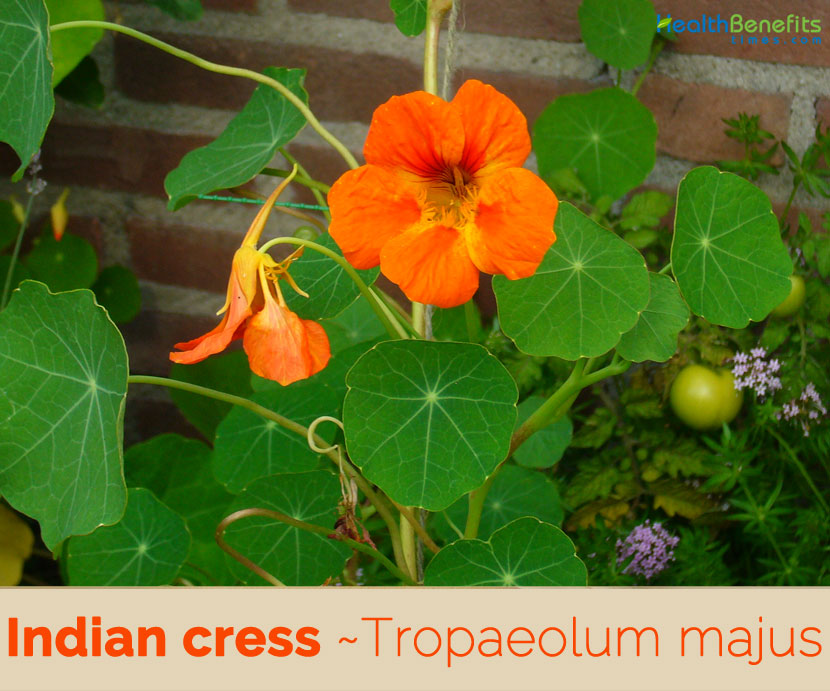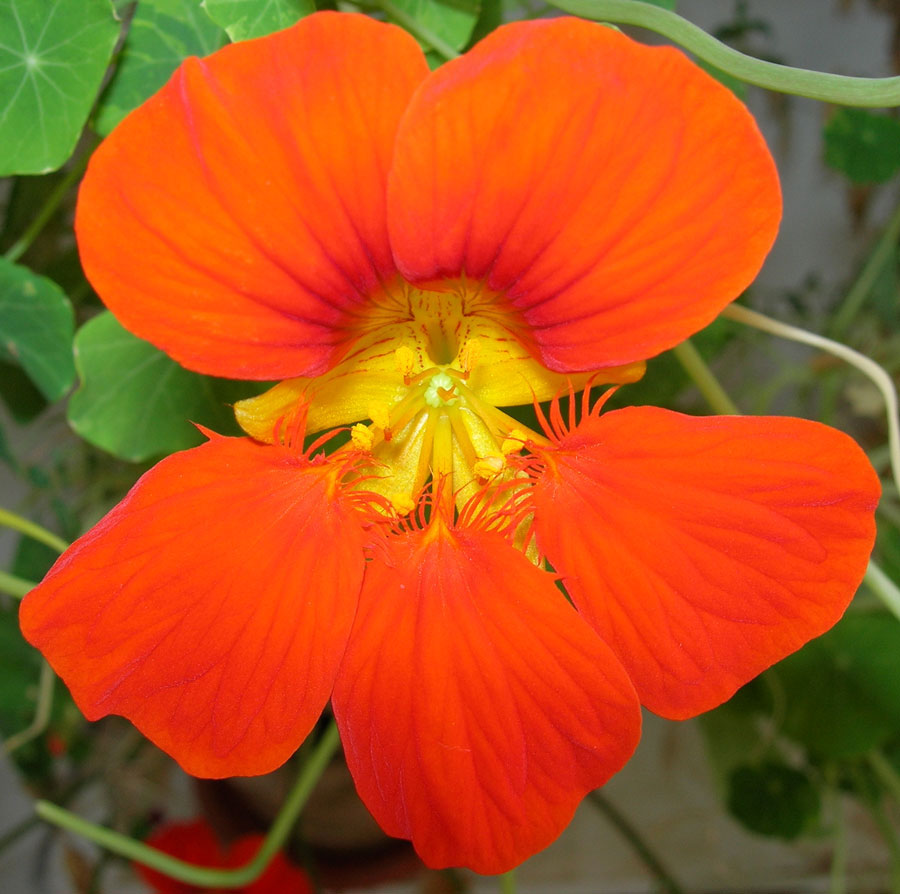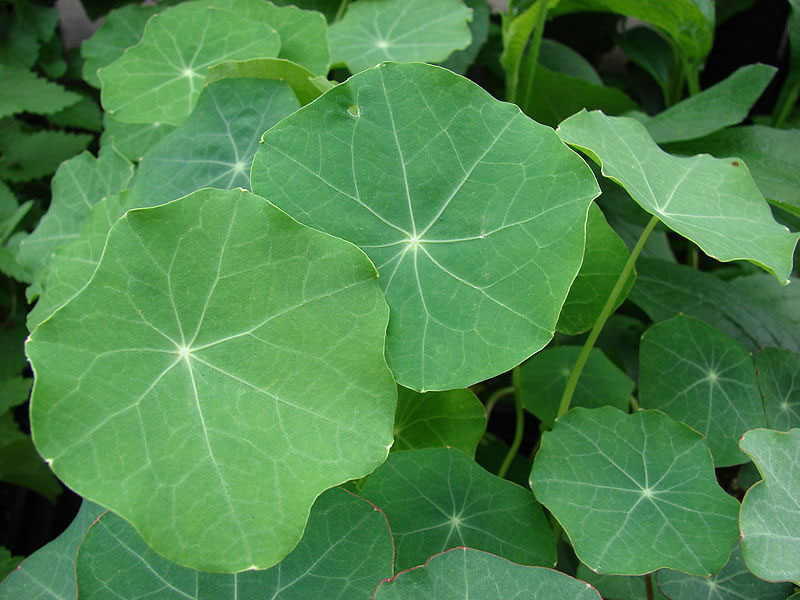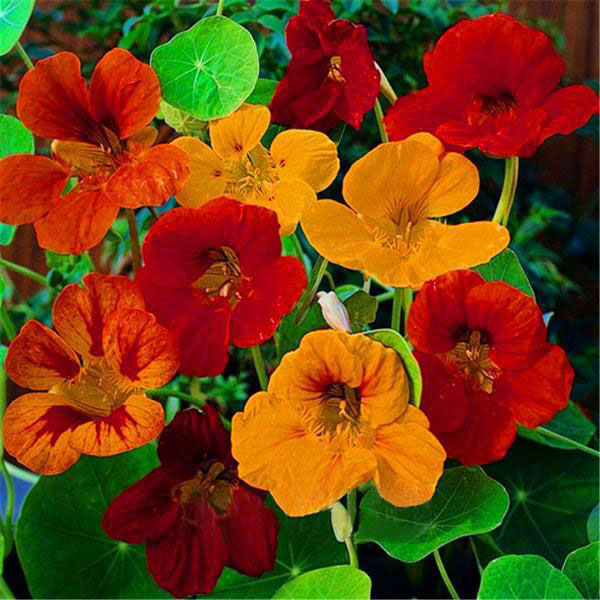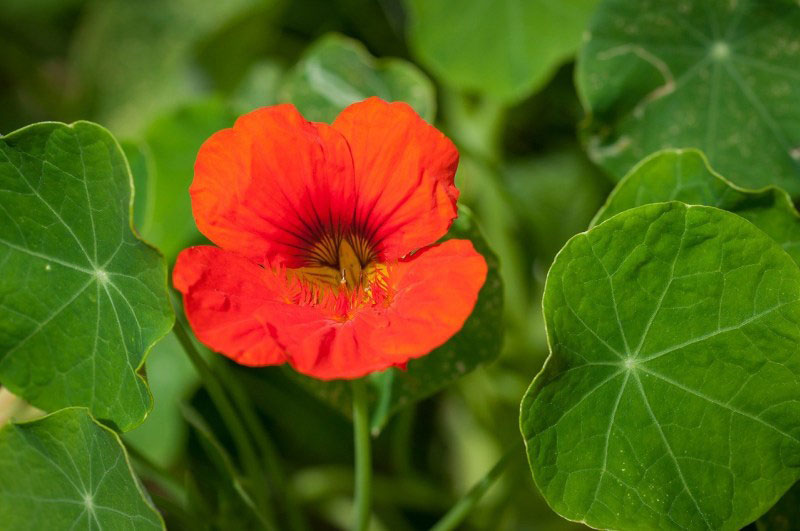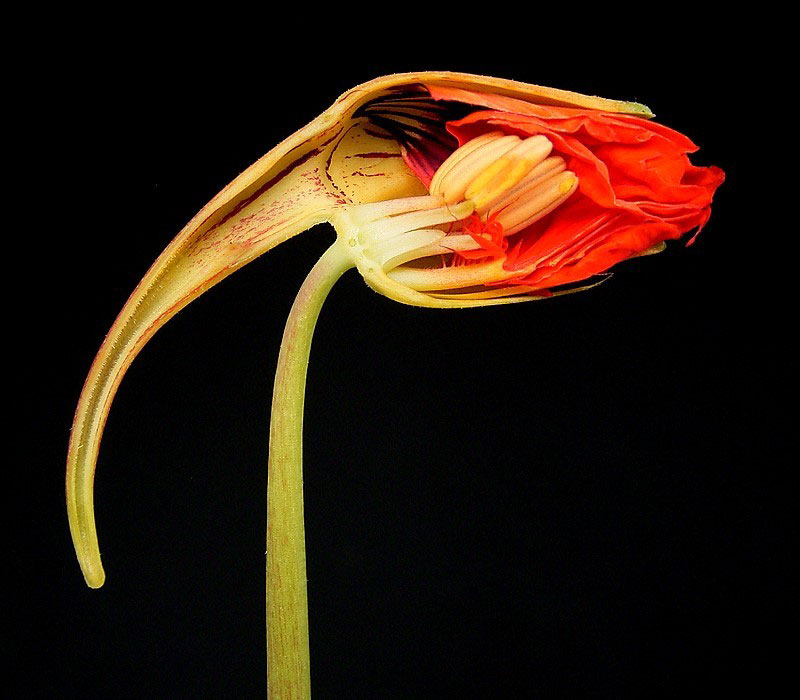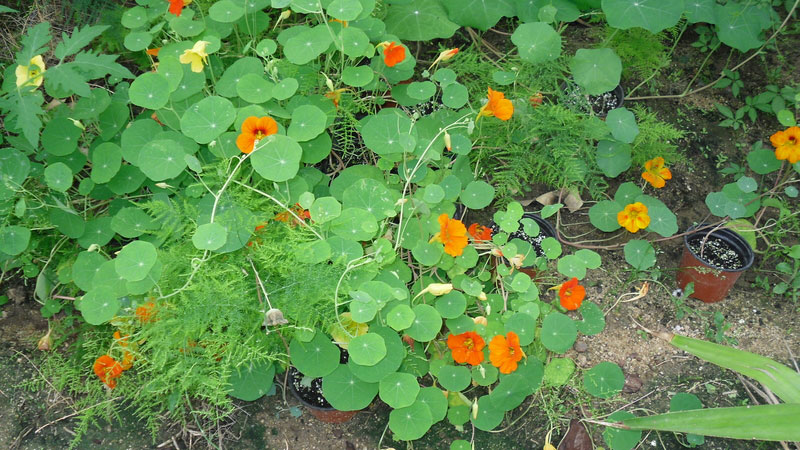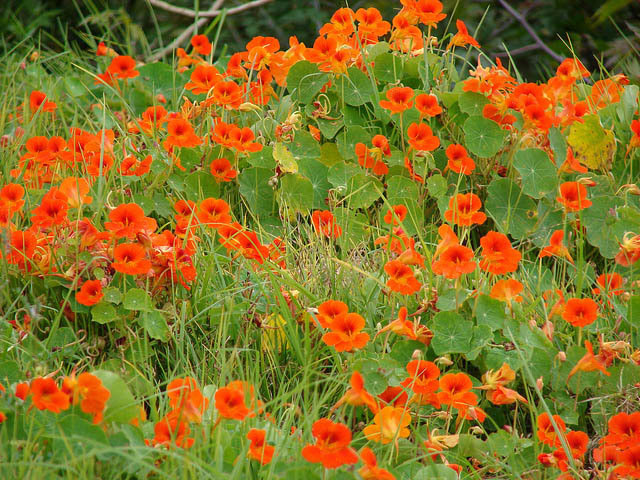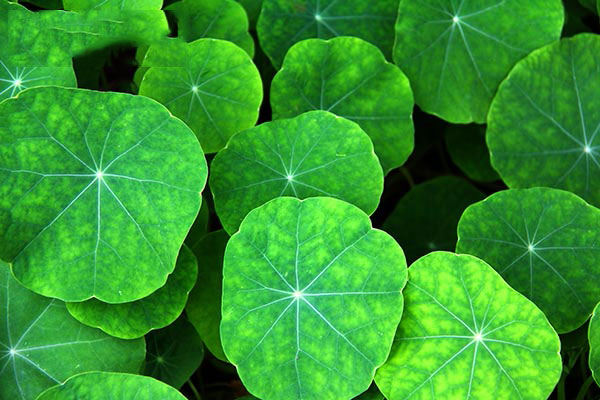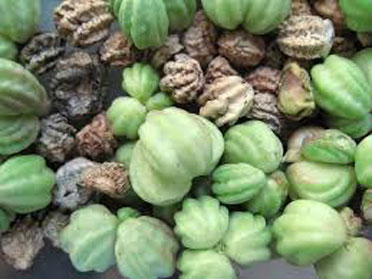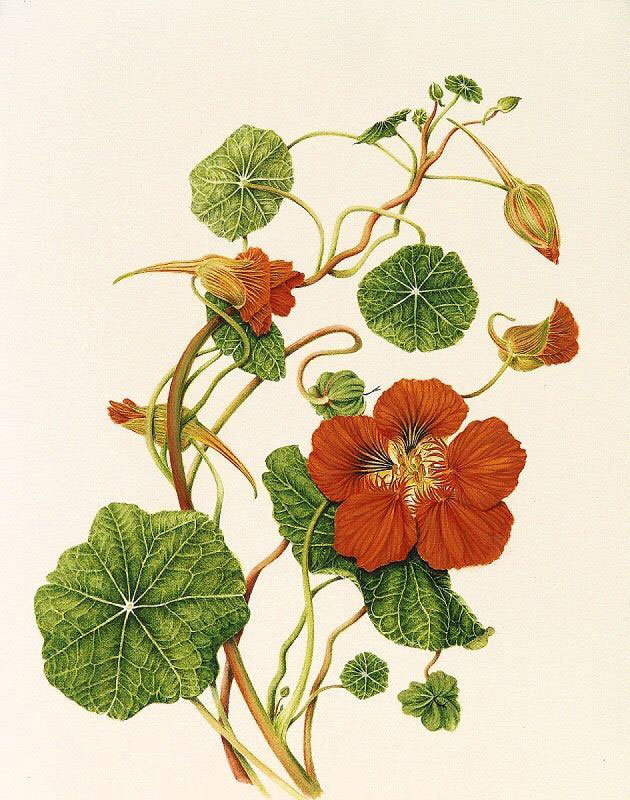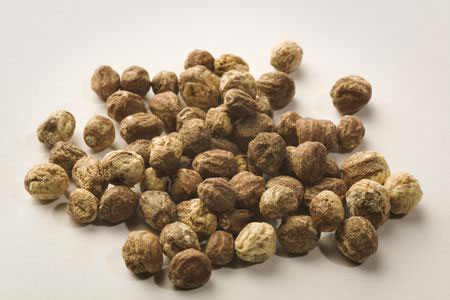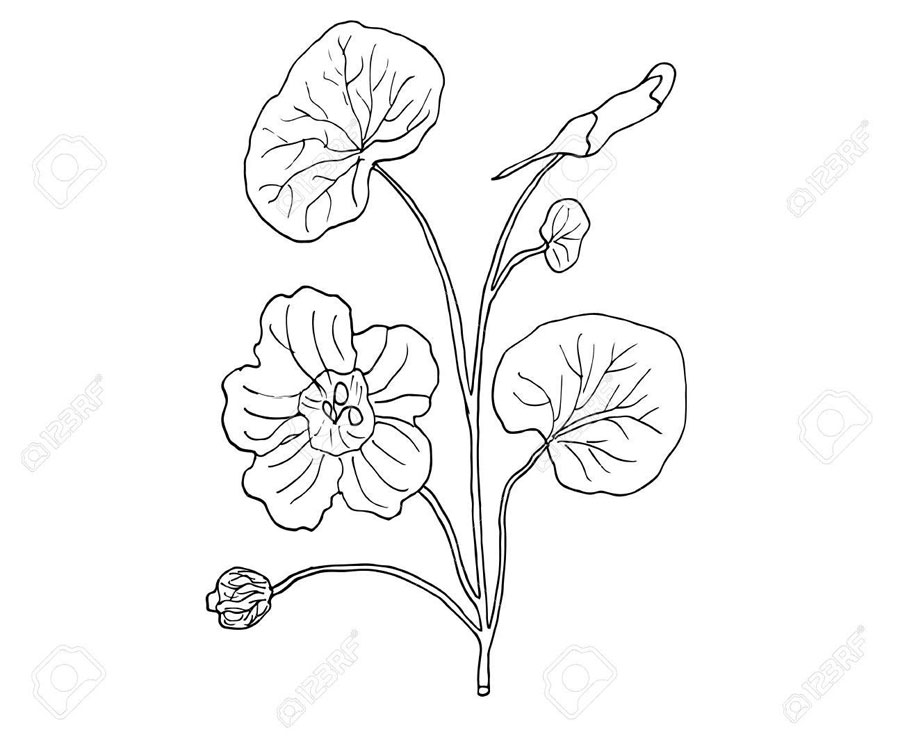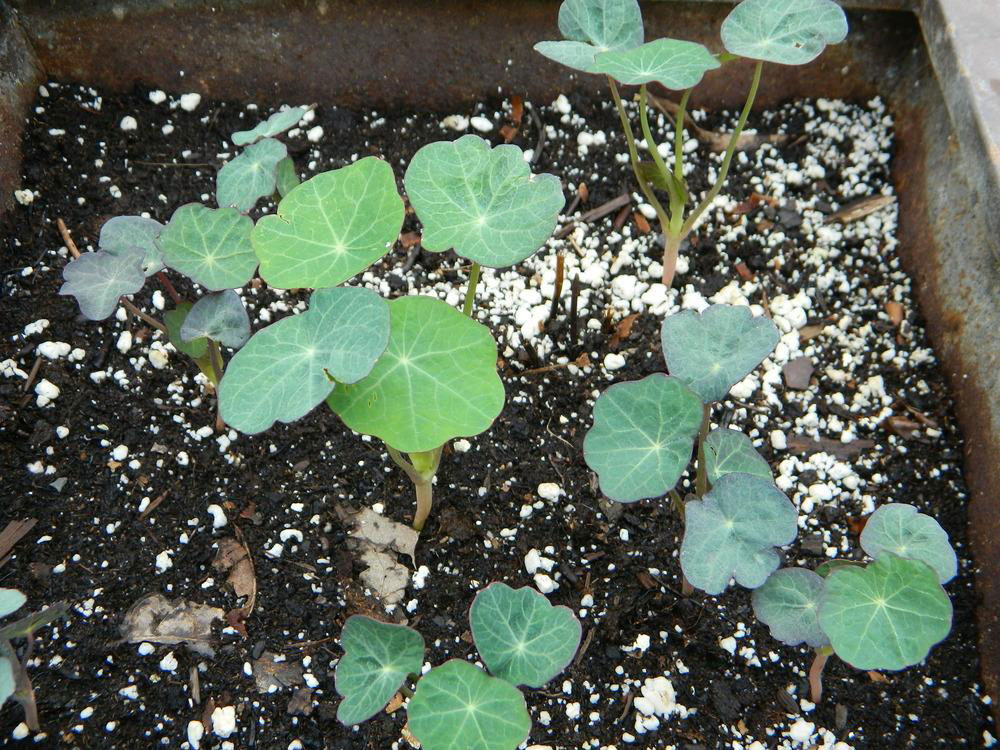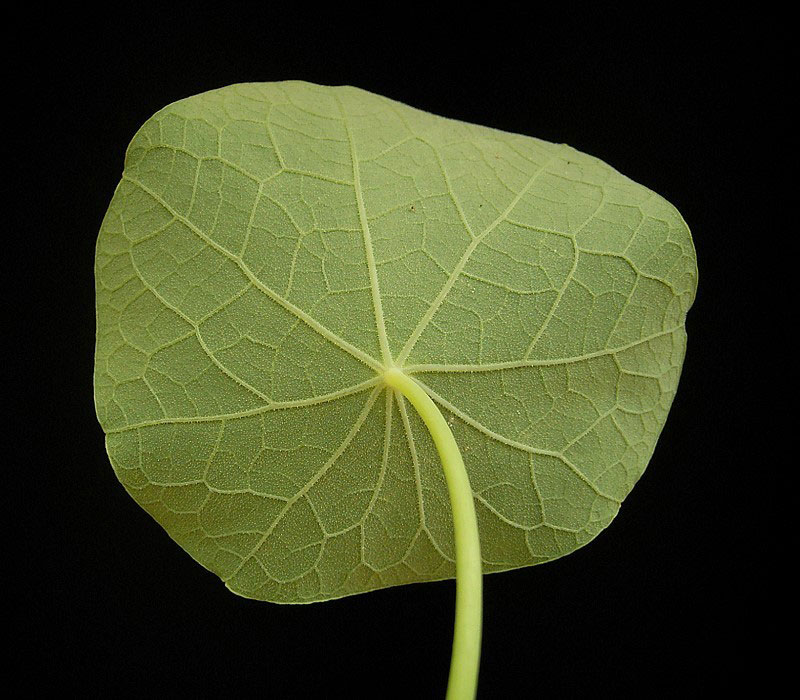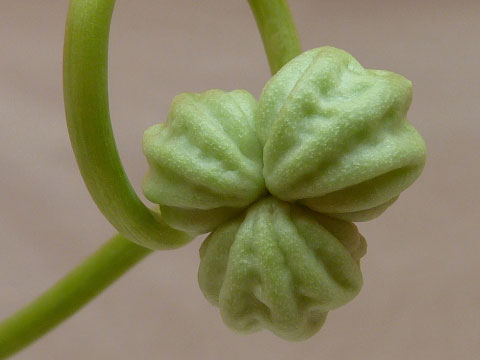| Indian cress Quick Facts |
| Name: |
Indian cress |
| Scientific Name: |
Tropaeolum majus |
| Origin |
Originated in South America in the Andes from Peru, Bolivia north to Colombia. |
| Colors |
Pale green at first turning pale brown when mature |
| Shapes |
2 cm broad, three-segmented, each segment with a single large seed 1–1.5 cm long |
| Taste |
Pungent |
| Health benefits |
Maintain health of respiratory system, Maintain the health of urinary tract, Hair-growth Stimulation, Promoting New Blood Cells Formation, Maintain digestive health, Healthy functioning of brain, Helpful against insomnia, Good for Skin |
Nasturtium, Tropaeolum majus, commonly known as Indian cress, is a very popular and cottagey plant, found in many gardens – but not generally thought of as an herb. It is a species of flowering plant in the family Tropaeolaceae. The plant originated in South America in the Andes from Peru, Bolivia north to Colombia. It was introduced into Europe in the sixteenth century and elsewhere subsequently. Some of the most popular common names of the plants are Climbing Nasturtium, Common Nasturtium, Empress of India, Garden Nasturtium, Indian Cress, Monks Cress, Nasturtium and large Indian cress. It is widely cultivated, both as an ornamental and as a medicinal plant.
Genus name comes from the Greek word tropaion meaning a trophy and the Latin word tropaeum named by Linnaeus for its similarity to a classical trophy. Nasturtiums are warm weather annuals that have been popular in herb gardens, cottage gardens and flower gardens for many years. Cultivars and hybrids sold under the name of Tropaeolum majus are generally referred to as common nasturtiums or garden nasturtiums. This herbaceous annual adds up rainbows of cheerful color in annual beds and borders. Its trailing cultivars are used on low fences or trellises, on a gravelly or sandy slope, or in a hanging container. Nasturtiums are not only grown for their beautiful flowers but also because both their leaves and flowers are edible and used in salads, revealing a delicately peppery taste.
Plant Description
Indian cress is a sprawling or climbing, succulent annual or short-lived herbaceous, fast growing perennial herb that grows about 3–6 ft. (0.91–1.83 m) tall. The plant is found growing in disturbed sites especially adjacent to gardens and dumps, shrub land, herb field, wetland, stream sides, watercourses (i.e. riparian vegetation), urban bush land, roadsides, railways and waste areas. The plant thrives in poor to average, slightly acidic soil and prefers well-drained soil. The stems and leaf stalks (i.e. petioles) are pale green in color, hairless (i.e. glabrous) and somewhat fleshy (i.e. succulent).
Leaves
The green or slightly bluish-green leaves are borne on stalks (i.e. petioles) that are 5-30 cm long that are attached to the center of the leaf undersides (i.e. the leaves are peltate). These leaves (4-15 cm across) are rounded in shape (i.e. orbicular) with entire, wavy (i.e. undulate), or slightly lobed (i.e. sinuate) margins. Leaves are hairless (i.e. glabrous) and have numerous prominent veins that radiate outwards from the center of the leaf blade.
Flowers
Flowers are borne singly in the upper leaf forks (i.e. axils) on stalks about 15-25 cm long. These flowers are 2.5-7 cm across and have five yellow, orange or red petals that are 2.5-6 cm long and five sepals that are 1-2 cm long that are fused together at the base. One of these sepals is formed into a nectar-bearing spur (2.5-4 cm long) that is either straight or slightly curved. Flowers also have eight stamens and an ovary topped with a style and stigma. Flowering occurs mostly in spring, but also in summer and autumn. Flowers are seen blooming from July to September.
Fruits
Fertile flowers are followed by fruit that consists of a set of 3 indehiscent, 1-seeded carpels or nuts. They are broadly ovate with prominent longitudinal ridges. Each single nut is 9-14mm long and 6-8mm across, pale green at first turning pale brown when mature. They fall off without any mechanical dispersion, but since they can float, they are detached effectively by movement of water.
Popular varieties of Indian cress
Some readily available cultivars of Indian cress include:
a. Alaska series
It has heavily variegated leaves (green mottled with creamy white) on bushy plants with bright single flowers in a variety of colors held above the foliage.
b. Empress of India
It has a brilliant single crimson red flowers and dark, purplish foliage. It is a classic compact variety that is good in pots.
c. Gleam
It has double flowers in a mix of colors on semi-trailing plants about 12 inches tall.
d. Jewel series
It is a bushy, dwarf plants with double and semi-double flowers in red, pink, yellow and orange. It has unusual fluted petals that add interest to containers.
e. Jewel of Africa
It is a trailing type with variegated leaves.
f. Peach Melba
It has semi-double yellow flowers with a red-orange throat. It is a dwarf plant that is good in containers.
g. Tip Top series
It is an improved ‘Alaska,’ with mottled and spotted leaves and bright flowers in yellow, red and orange.
h. Tom Thumb series
It is a shorter (6-9”) type with large, vivid blooms in bright yellow, red and orange. It is considered a good choice for smaller gardens.
i. Vesuvius
It has brilliant deep orange flowers on compact plants.
j. Whirlybird’ series
It is a compact, mid-green plants (9-12”) with semi-double flowers in shades of orange, yellow, salmon, deep mahogany and rose. The ruffled flowers lack the typical flower spur, so they sit flat on the tops of the stems.
k. Canary Creeper
It is actually a different species (T. peregrinum) that is a perennial vine in zones 9-11 or grown as an annual. It has bright yellow, fringed flowers that look somewhat like bird’s wings and 5-lobed, light green leaves. It is very fast growing.
Health Benefits of Indian cress
Both leaves and petals of the nasturtium plant are loaded with nutrition and contain high levels of vitamin C. It has the ability to improve the immune system, tackling sore throats, coughs, and colds, as well as bacterial and fungal infections. It also contains high amounts of manganese, iron, flavonoids, and beta carotene. Listed below are few of the popular health benefits of using Indian Cress
1. Maintain health of respiratory system
The plant has been known to be effective in treating issues related to the upper respiratory system. It is one of the best known remedies for treatment against cough and bronchitis.
2. Maintain the health of urinary tract
It has been known to be effective in treating numerous urinary tract issues as it tends to possess anti-bacterial as well as anti-viral properties. It prevents development of any urinary tract infections and any symptoms related to same.
3. Maintain digestive health
The herb has been known to promote the digestive health of the body and helps in smooth functioning of the body. The herb has been known to help in easy absorption of nutrients and hence maintain the health of the overall system.
4. Healthy functioning of brain
One of the lesser known advantages of this herb is its ability to promote healthy functioning of brain. It tends to promote healthy signal transmission and therefore also prevents issues such as Alzheimer’s from occurring.
5. Helpful against insomnia
The plant has been known to be effective in treating sleeping disorders such as insomnia. It calms the nerves and thus promotes healthy sleep.
6. Promoting New Blood Cells Formation
In much more serious case like blood disorder, using nasturtium leaves as part of herbal treatment is highly recommended because years of experience and recent studies found that nasturtium leaves is very effective in promoting the formation of new blood cells in the body.
7. Hair-growth Stimulation
Nasturtium plant is not only beautiful to see but also rich of beneficial properties. One of the benefits of this plant is as natural hair treatment. Thinning hair might be not as serious as it sound but for women, this condition is a worst nightmare. It can be proven by how much money they will spend for healthy hair. Applying the paste of nasturtium leaves in your scalp could help stimulate the capillaries and enhance the circulation of blood, nutrients and oxygen in your scalp. Good circulation means good hair growth.
8. Good for Skin
Nasturtium leaves consist of antiseptic properties which could help you fighting bacteria effectively. Use it as mask could help you getting rid of acne from your face and the vitamin C contained in this flower plants could make the look of your skin fairer and balance the tone of your skin.
https://www.youtube.com/watch?v=Wuna9dc_K3E
Traditional uses and benefits of Indian cress
- It is used in Andean herbal medicine as a disinfectant and wound-healing herb, and as an expectorant to relieve chest conditions.
- All parts of the plant appear to be antibiotic and an infusion of the leaves can be used to increase resistance to bacterial infections and to clear nasal and bronchial catarrh.
- Remedy seems to both reduce catarrh formation and stimulate the clearing and coughing up of phlegm.
- It is used to treat wounds and infections of the urinary tract and the respiratory tract (such as bronchitis, anginas and flu).
- Traditionally, Indian cress has been used as a stimulant for hair growth.
- Decorative flowers were used as a topical wound treatment to prevent the onset of infections.
- Flowers are also notably effective in addressing various respiratory conditions such as asthma, bronchitis, inflammatory diseases, and cough as well as cold, flu, and emphysema.
- Ornamental flowers are found to improve the body’s digestive profile.
- It is shown to boost liver function and performance as well as improve the organ’s bile secretion.
- Plant’s antibiotic properties also help relieve sore throat.
- Edible flower is shown to lower the risk of developing diabetes.
- Nasturtiums are found to address various kidney and urinary tract diseases.
- Edible flower is traditionally used to relieve muscle pain and boost both physical and mental health.
- It is known to regulate menstrual cycles in women and improve sex drive in men.
- It is found to address various skin disorders such as impurities, rashes, and injuries as well as relieve hair and scalp diseases.
- It is also known to alleviate eye diseases.
- When applied externally, it may also work against various fungal infections, including a yeast infection.
- Additionally, it was used traditionally to treat muscular pain.
- It has long been used in Andean herbal medicine as a disinfectant and wound-healing herb, and as an expectorant to relieve chest conditions.
- All parts of the plant appear to be antibiotic and an infusion of the leaves can be used to increase resistance to bacterial infections and to clear nasal and bronchial catarrh.
- Remedy seems to both reduce catarrh formation and stimulate the clearing and coughing up of phlegm.
- Glycoside found in the plant reacts with water to produce an antibiotic.
- Plant has antibiotic properties towards aerobic spore forming bacteria.
- Extracts from the plant have anticancer activity.
- Plant is taken internally in the treatment of genito-urinary diseases, respiratory infections, scurvy and poor skin and hair conditions.
- Externally it makes an effective antiseptic wash and is used in the treatment of baldness, minor injuries and skin eruptions.
- Plant is antiseptic, diuretic, antiscorbutic and expectorant and therefore good for head colds.
- Plant is ingested internally in the treatment of genitourinary diseases, respiratory infections, scurvy and poor skin and hair conditions.
- It is a medicinal herb popularly used in Brazil for treatment of inflammatory and cardiovascular diseases.
- It has long been used in Andean herbal medicine as a disinfectant and wound-healing herb and as an expectorant to relieve chest conditions by reducing catarrh formation and stimulate the clearing and coughing up of phlegm.
- Fresh leaves were used in traditional medicine for the treatment of infected wounds and the gall bladder, as diuretic, as aphrodisiac and as remedy against chronic diseases such as obstructive pulmonary disease, cystitis pyelitis and infections of kidneys and bladder.
- Leaves are reported to possess antibacterial, anti-fungal, antiseptic, aperient, depurative, diuretic, emmenagogue, expectorant, purgative, aphrodisiac, vulnerary, rejuvenative, anti-neoplastic, demulcent, laxative and stimulant activities.
Culinary Uses
- Flower has most often been consumed, making for an especially ornamental salad ingredient.
- Unripe seed pods can be harvested and dropped into spiced vinegar to produce a condiment and garnish.
- Leaves are used as flavoring in mixed salads.
- Chopped fresh leaves can be added to cream cheeses and various egg dishes to give a pepper-like taste.
- Flowers look great as garnishes.
- Fruits can be chopped and used instead of horseradish when making a tartar sauce.
- Leaves can be consumed raw and has hot watercress.
- Young seed pods are consumed raw.
- These are even hotter than the flowers or leaves.
- They can also be harvested whilst immature and pickled for use as a caper substitute.
- Dried mature seeds can be ground into a powder and used as a pepper substitute or pressed to make oil.
- Nasturtium flowers bud and leaves have a peppery flavor similar to watercress and can be eaten raw.
- Nasturtium flower is one of the most popular and best-known edible flowers with attractive blossoms that have a sweet, peppery spicy flavor similar to watercress.
- Buds and flowers can be added to salads, sandwich spread, vegetable dishes and butter and can be used to flavor vinegar or stuffed or crystallized.
- Flowers combine well with cream cheese or butter in canapés or in a cheese and tomato sandwich.
- Buds can be used as caper substitute.
- Blossoms make a nutritious addition to salads and can be an attractive, decorative garnish to steak and casseroles.
- Leaves and young leafy shoots as well as pickled fruits and flower buds can be used for seasoning.
- Some recipes with nasturtium flowers reported include nasturtium salad vinegar, nasturtium cheese dip and grilled aubergine salad with egg and nasturtium flowers.
- Flowers make stunning garnishes for meat, fish or vegetable dishes.
Other uses
- Seeds yield a high percentage of a drying oil that can be used in making paints, varnish etc.
- An insecticide can be made from an infusion of leaves and soap flakes.
- Indian cress is often planted in gardens and its leaves and flowers are used to decorate dishes or eaten with salad.
- Indian cress is a popular ornamental garden plant.
- Indian cress are also widely considered as useful companion plants as they repel many insect pests and attract beneficial predatory insects, they are also useful as trap crop against black fly aphids.
Other Different uses for Indian cress
Nasturtiums are edible
Not only do they look good, but they taste great too. In fact, you can eat the entire plant! Leaves have a slightly warm peppery flavor similar to watercress. Flowers are milder and the seeds, though hot and fragrant, are edible too. Words of warning however, never eat any flower or plant that has been treated with pesticides or other chemicals!
Rich in minerals
Leaves are high in vitamin C, iron and other minerals and the flowers are plentiful in vitamins B1, B2, B3 and C and also contain manganese, iron, phosphorus and calcium.
Pest repellent
These herbs work in several ways to deter pests. Nasturtiums mask the scent of plants that are commonly targeted by pests, disguise the leaves of food plants that pests are looking for and actively repel certain pests and attract others as a trap crop. They pack a real punch by secreting a mustard oil that some insects are attracted to.
Medicinal health benefits
Leaves have powerful antibiotic, antimicrobial, antioxidant and general tonic actions, aid digestion and have apparently been found to be effective against some microorganisms that are resistant to common antibiotics, help prevent and relieve coughs, colds and flu and eating 3 seeds daily helps build up resistance to viruses, colds and measles. One leaf eaten per hour as soon as you get a sore throat can severely reduce the severity of the infection. It is also used as an expectorant, anti-fungal and antiseptic.
Companion plants
According to the useful book ‘Permaculture Plants’ nasturtiums also makes great companion plants to turnips, radishes, cucumbers and zucchini.
Attract beneficial insects
Sweet nectar in the flower attracts helpful pollinating insects like bees and butterflies, hoverflies (that feed on pests) and nectar eating birds.
Great value space fillers for frugal gardeners
Healthy plant can cover three square meters so you save heaps by not having to buy lots of other plants to cover the same space.
Cheerful cut flowers
Pick them and pop in a vase on your dining table or kitchen bench with their attractive foliage they make a pretty edible arrangement. They keep well in water but even better, eat them or use as a garnish with each meal and then replenish from your garden! The bright green rounded leaves are just as attractive as the flowers.
Long flowering plant
These annual prolific bloomers provide great value flowering for prolonged periods most of the year until frost.
Heaps of free seeds
You get a huge number of new nasturtium plants from just one! When the flower dies off, a seed head forms. If you don’t pick and save these, they will voluntarily drop to the ground and self sow.
Colorful plant
Nasturtiums have to be one of the most cheerful flowers to have in your garden. Some varieties have variegated leaves so you can enjoy stripy white and green colors as well.
Living Mulch/Ground Cover
Because of the plentiful leaf growth, Indian cress makes wonderful mulch if you chop and drop it around your plants. Or grow nasturtiums as a ground cover to shade your soil and reduce moisture loss. It will break down and decompose at the end of their life, adding nutrients to your soil.
Fast flowers and living artwork
Indian cress plants grow quickly and are a great choice for covering a horizontal or vertical area in a short space of time.
Flavor improver
Indian cress is an excellent companion for many plants, improving their growth and flavor.
Great garnish
Both Indian cress leaves and flowers make pretty garnishes on any plate.
Weed out weeds
Once established, the thick cover of Indian cress leaves and flowers will provide enough shade to overcome most weed competition.
Poultry pharmacy
Sharp chooks will benefit from the strongly antiseptic and medicinal properties in the leaves. Given a chance your chickens will snack on the seeds and self-medicate. Indian cress is a vermifuge (de-wormer) so is good to use for worming your chickens. It is also great for chooks with nervous ailments and depression. The strong scent also repels annoying insect pests. Toss them in with your chicken’s regular feed.
Fragrant flowers
Light spicy fragrance provides a delicate scent, particularly planted near a seating area.
Make beautiful pressed flowers
If you are crafty or have children, making your own wrapping paper, cards and other craft is a great way to preserve the beauty of these lovely flowers and leaves.
Ways to use nasturtium
Essential oils extracted from Indian cress can be used to address common colds, while tinctures made from the flower are effective in combating hair loss. Likewise, the flowers can be added to bath water to treat various skin disorders. Edible flower can also be made into a powerful tea to relieve skin and eye conditions. On the other hand, its leaves are an excellent salad green while the small buds can be pickled. Leaves and stems also make for an ideal pesto alternative.
Nasturtium Pesto
Ingredients
Directions
- Bring a large pot of water to a boil; prepare an ice-water bath and set aside.
- Add nasturtium leaves to boiling water; cook for 10 seconds.
- Drain and transfer to ice-water bath until cool. Drain and set aside.
- Place leaves, pine nuts, garlic, and oil in the jar of a blender; blend until smooth.
- Transfer mixture to a medium bowl and fold in stems and cheese.
Precautions
- If taken during early pregnancy, it might induce menstruation and cause a miscarriage.
- Pregnant or breastfeeding women should not use this herb.
- People with kidney diseases or ulcers of the stomach or intestinal tract should not use this herb in any form either.
- Avoid for infants or small children and patients with gastrointestinal ulcers or kidney disease, Irritation of the mucous membrane of the gastrointestinal tract.
- Excess use may cause skin irritation.
- Due to the high content of oxalic acid in the leaves, it would be advised to be avoided by those suffering from kidney stones.
- Anyone currently taking medication should consult their health care practitioner before adding new compounds to their personal care routine, in case of possible interactions or side effects.
- It is unsafe for children to use nasturtium by mouth. There is also not enough information about the safety in children when applied on skin directly.
- Avoid taking nasturtium if you have stomach or intestinal ulcers. It is unsafe for you.
- Nasturtium might be safe for adults when directly applied to the skin along with other natural remedies. However, it causes side effects of skin irritation if used for long time.
References:
https://www.itis.gov/servlet/SingleRpt/SingleRpt?search_topic=TSN&search_value=505615#null
https://davesgarden.com/guides/pf/go/703/
http://www.hear.org/pier/species/tropaeolum_majus.htm
http://www.missouribotanicalgarden.org/PlantFinder/PlantFinderDetails.aspx?taxonid=264612&isprofile=0&
http://www.floracatalana.net/tropaeolum-majus-l
https://plants.usda.gov/core/profile?symbol=TRMA7
https://en.wikipedia.org/wiki/Tropaeolum_majus
https://npgsweb.ars-grin.gov/gringlobal/taxonomydetail.aspx?id=40686
https://www.uniprot.org/taxonomy/4020
http://www.theplantlist.org/tpl/record/kew-2522052
https://gd.eppo.int/taxon/TOPMA
https://pfaf.org/user/plant.aspx?LatinName=Tropaeolum+majus
http://www.missouribotanicalgarden.org/PlantFinder/PlantFinderDetails.aspx?kempercode=b736
https://pdfs.semanticscholar.org/4ab5/63d2bcb41041a882965a8251ca74a7494cba.pdf
Comments
comments


